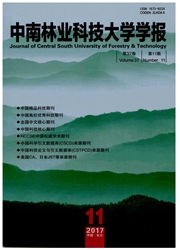

 中文摘要:
中文摘要:
通过对香根草根-土复合体的室内直剪试验,探讨了根系直径和分布方式对根.土复合体抗剪强度的影响。研究发现,在其它条件相同的情况下,垂直加斜交等量布根时,复合体的抗剪强度最高;垂直加水平等量布根时,其抗剪强度最低;其它布根方式时,其抗剪强度介于上述二者之间。研究表明,根系分布方式对根-土复合体的粘聚力的影响是非常明显的,而对其内摩擦角的影响却并不明显。同时,在相同根系数量和布根方式条件下,随着根系直径的增大根-土复合体的抗剪强度及内摩擦角先增大后减小。当根系直径达到某一值时,根-土复合体的抗剪强度达到最大值。研究结果对进一步探索生态护坡工程中根-土复合体的抗剪强度形成机理具有重要的理论意义,也为生态护坡工程的强度和边坡稳定分析提供了理论依据。
 英文摘要:
英文摘要:
The effects of root diameter and root distribution on the shear strength of vetiver root-soil composites have been studied, through a series of indoor direct shear tests on these composites. When the root numbers of vertical distributed are equal to that of oblique, the study found that the shear strength of composite is the highest, under the same conditions. And when the root numbers of vertical distributed are equal to that of horizontal, the shear strength of composite is the lowest. In any other root distribution mode, the shear strength of the composite is somewhere in between the above two cases. Meanwhile, the study shows that the effect of root distribution on the cohesive force of root-soil composite is very obvious, but the influence of it on the internal friction angle is not obvious. Moreover, with the increase of root diameter, the shear strength and the internal friction angle of this composite are increased first and then are decreased, if the root numbers and the distribution mode are the same. When the root diameter is reached to a certain value, the shear strength of this composite is reached to the maximum. The research results have important theoretical significance for farther exploring the mechanism of shear strength of root-soil composite in ecological slope protection engineering, and it also provides a theoretical basis for the strength and slope stability analysis in this field simultaneously.
 同期刊论文项目
同期刊论文项目
 同项目期刊论文
同项目期刊论文
 期刊信息
期刊信息
